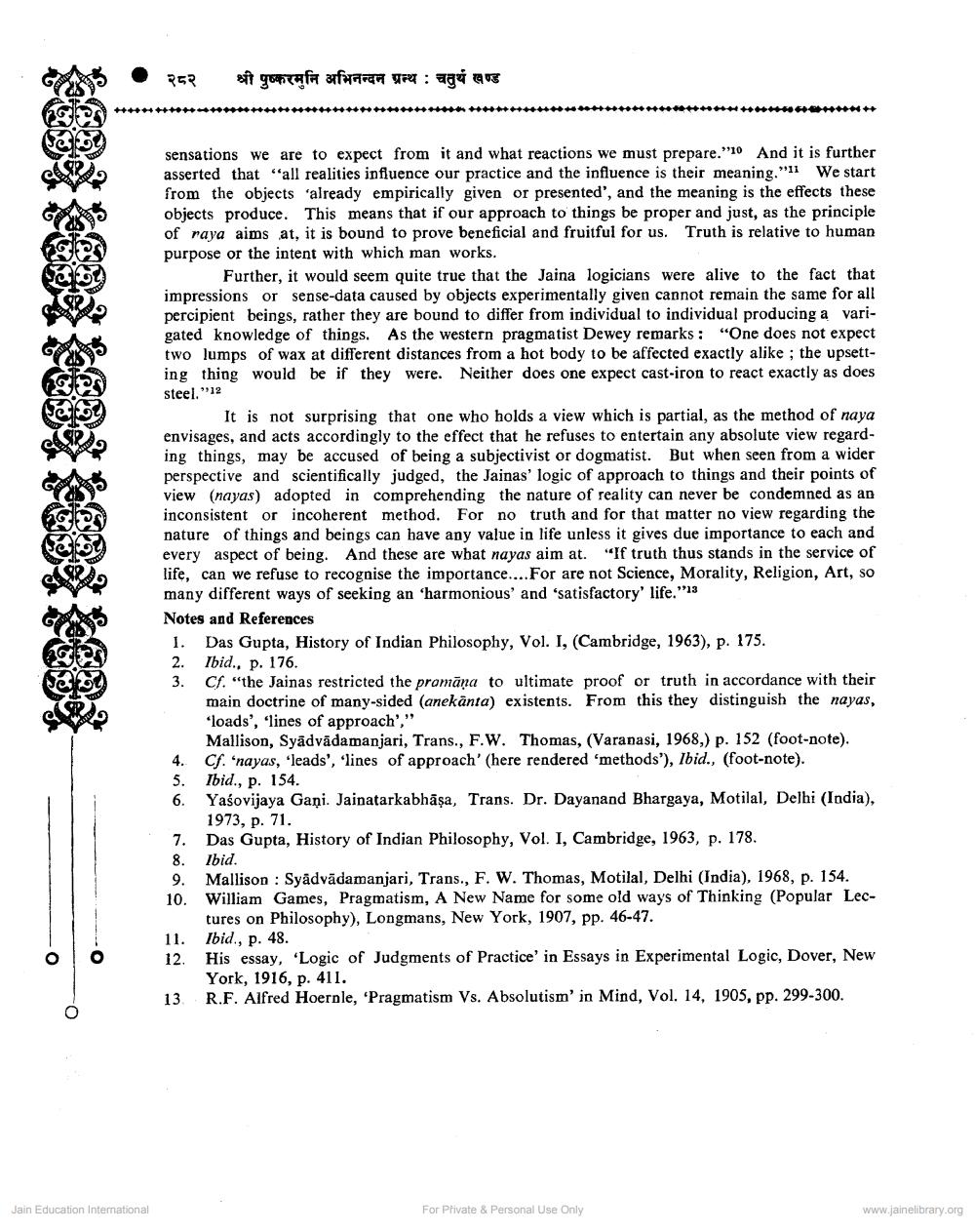________________
२८२
श्री पुष्करमुनि अभिनन्दन ग्रन्थ : चतुर्थ खण्ड
++++++++++++
+++++++++++++++++++++++++++++++++++++++++++++++++ M
A MM A ....... .........--+++
+
++++++++++++
++++++
+++++++
+++++++
sensations we are to expect from it and what reactions we must prepare."10 And it is further asserted that "all realities influence our practice and the influence is their meaning."11 We start from the objects 'already empirically given or presented', and the meaning is the effects these objects produce. This means that if our approach to things be proper and just, as the principle of raya aims at, it is bound to prove beneficial and fruitful for us. Truth is relative to human purpose or the intent with which man works.
Further, it would seem quite true that the Jaina logicians were alive to the fact that impressions or sense-data caused by objects experimentally given cannot remain the same for all percipient beings, rather they are bound to differ from individual to individual producing a varigated knowledge of things. As the western pragmatist Dewey remarks: “One does not expect two lumps of wax at different distances from a hot body to be affected exactly alike; the upsetting thing would be if they were. Neither does one expect cast-iron to react exactly as does steel."12
It is not surprising that one who holds a view which is partial, as the method of naya envisages, and acts accordingly to the effect that he refuses to entertain any absolute view regarding things, may be accused of being a subjectivist or dogmatist. But when seen from a wider perspective and scientifically judged, the Jainas' logic of approach to things and their points of view (nayas) adopted in comprehending the nature of reality can never be condemned as an inconsistent or incoherent method. For no truth and for that matter no view regarding the nature of things and beings can have any value in life unless it gives due importance to each and every aspect of being. And these are what nayas aim at. "If truth thus stands in the service of life, can we refuse to recognise the importance.... For are not Science, Morality, Religion, Art, so many different ways of seeking an 'harmonious' and 'satisfactory' life."'13 Notes and References
1. Das Gupta, History of Indian Philosophy, Vol. I, (Cambridge, 1963), p. 175. 2. Ibid., p. 176. 3. Cf. "the Jainas restricted the promāna to ultimate proof or truth in accordance with their
main doctrine of many-sided (anekänta) existents. From this they distinguish the nayas, "loads', 'lines of approach'," Mallison, Syädvādamanjari, Trans., F.W. Thomas, (Varanasi, 1968, p. 152 (foot-note).
Cf. 'nayas, 'leads', 'lines of approach' (here rendered 'methods'), Ibid., (foot-note). 5. Ibid., p. 154. 6. Yaśovijaya Gaņi. Jainatarkabhāșa, Trans. Dr. Dayanand Bhargaya, Motilal, Delhi (India),
1973, p. 71. 7. Das Gupta, History of Indian Philosophy, Vol. I, Cambridge, 1963, p. 178. 8. lbid. 9. Mallison : Syadvādamanjari, Trans., F. W. Thomas, Motilal, Delhi (India), 1968, p. 154. 10. William Games, Pragmatism, A New Name for some old ways of Thinking (Popular Lec
tures on Philosophy), Longmans, New York, 1907, pp. 46-47. 11. Ibid., p. 48. 12. His essay, 'Logic of Judgments of Practice in Essays in Experimental Logic, Dover, New
York, 1916, p. 411. 13 R.F. Alfred Hoerple, 'Pragmatism Vs. Absolutism' in Mind, Vol. 14, 1905, pp. 299-300.
Jain Education International
For Private & Personal Use Only
www.jainelibrary.org




